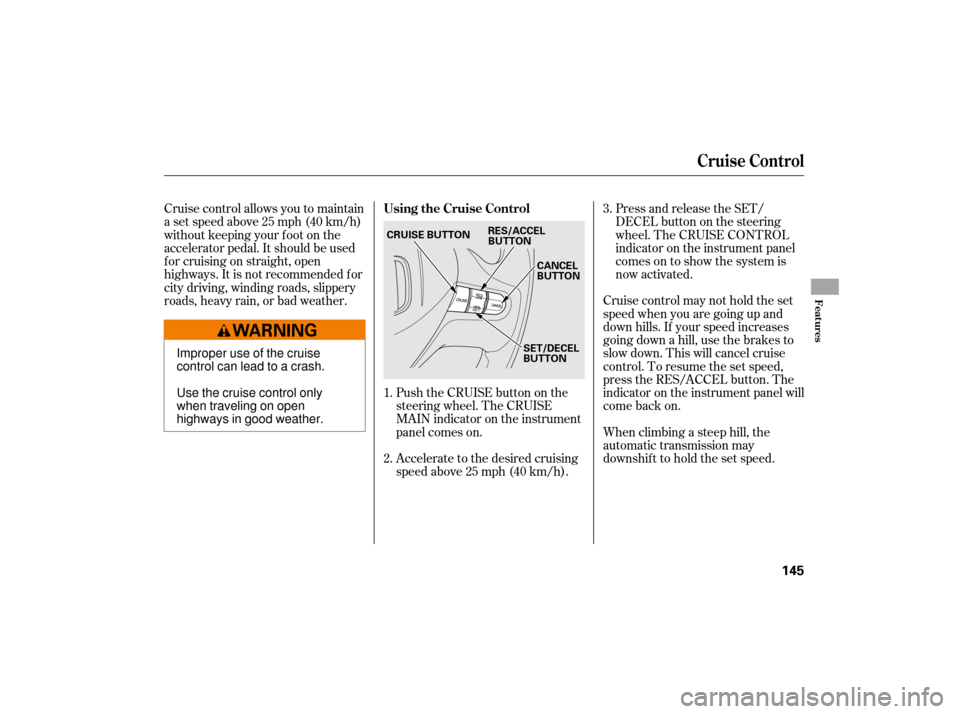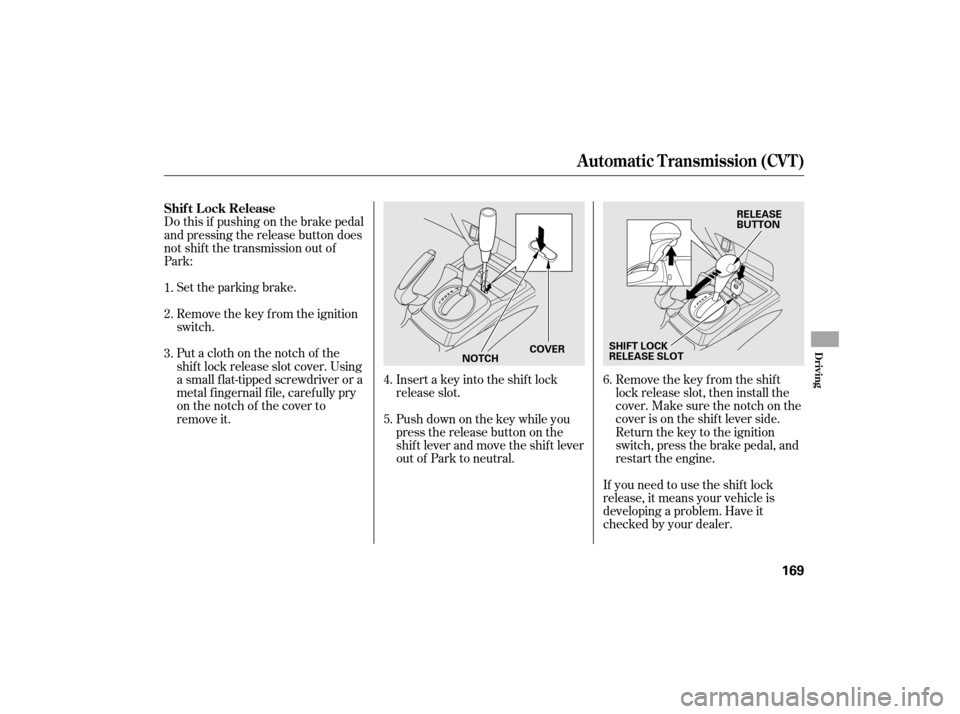Page 6 of 268
Your Vehicle at a Glance
You r Vehicle at a Glance
3
GAUGES INSTRUMENT PANEL INDICATORS AUDIO SYSTEM
AUXILIARY INPUT JACK ACCESSORY
POWER SOCKET
(P. 64)
(P. 58)
(P.9,24) PASSENGER’S FRONT AIRBAG
(P. 106)
DRIVER’S FRONT
AIRBAG
(P.9,24)
MIRROR CONTROLS
POWER DOOR LOCK
MASTER SWITCH
(P. 80)
POWER WINDOW
SWITCHES
FUEL FILL DOOR
RELEASE HANDLE
TRUNK RELEASE
HANDLE
(P. 86)
(P.
151)
(P. 143) DOOR
LOCK TAB
AUTOMATIC TRANSMISSION (CVT)
(P. 166)
Vehicle with navigation system is shown
(P.
92) (P. 96)
(P.
93)
(P. 80)
(P.
100)
CLIMATE CONTROL
SYSTEM
Page 59 of 268
Control Locations
56
POWER WINDOW
SWITCHES MIRROR CONTROLS
FUEL FILL DOOR
RELEASE HANDLE
(P. 151)
INSTRUMENT
PANEL INDICATORS
GAUGES AUDIO
SYSTEM
POWER DOOR LOCK
MASTER SWITCH
Vehicle with navigation system is shown (P.
106)
(P.
58)
(P. 64)
(P. 93)
(P. 80)
(P. 92) (P.
80)
(P.
100)
DOOR LOCK TAB
TRUNK RELEASE
HANDLE
(P. 86)
AUTOMATIC TRANSMISSION (CVT)
(P. 143)
AUXILIARY
INPUT JACK
(P. 166) ACCESSORY POWER
SOCKET
(P.
96)
CLIMATE CONTROL
SYSTEM
Page 148 of 268

Push the CRUISE button on the
steering wheel. The CRUISE
MAIN indicator on the instrument
panel comes on.
Accelerate to the desired cruising
speedabove25mph(40km/h).Cruise control may not hold the set
speed when you are going up and
down hills. If your speed increases
going down a hill, use the brakes to
slowdown.Thiswillcancelcruise
control. To resume the set speed,
press the RES/ACCEL button. The
indicator on the instrument panel will
come back on.
When climbing a steep hill, the
automatic transmission may
downshifttoholdthesetspeed.
Cruise control allows you to maintain
asetspeedabove25mph(40km/h)
without keeping your f oot on the
accelerator pedal. It should be used
f or cruising on straight, open
highways. It is not recommended f or
city driving, winding roads, slippery
roads, heavy rain, or bad weather.
Press and release the SET/
DECELbuttononthesteering
wheel. The CRUISE CONTROL
indicator on the instrument panel
comes on to show the system is
now activated.
1.
2. 3.
Using the Cruise Control
Cruise Control
Features
145
CANCEL
BUTTON
CRUISE BUTTON
RES/ACCEL
BUTTON
SET/DECEL
BUTTON
Improper use of the cruise
control can lead to a crash.
Use the cruise control only
when traveling on open
highways in good weather.
Page 166 of 268
........................
Preparing to Drive .164
.......................
Starting the Engine .165
.
Automatic Transmission (CVT) .166
...........................................
Parking .172
.............................
Braking System .173
...............
Anti-lock Brakes (ABS) .174
...........................
Towing a Trailer .175
This section gives you tips on
starting the engine under various
conditions, and how to operate the
automatic transmissions (CVT). It
also includes important inf ormation
on parking your vehicle and the
braking system.
Driving
Driving
163
Page 169 of 268
Honda’s Continuously Variable
Transmission’s unique design
provides a smooth, constant f low of
power. It is electronically controlled
f or more precise operation and
better f uel economy.These indicators on the instrument
panel show which position the shif t
lever is in.The ‘‘D’’ indicator comes on f or a
f ew seconds when you turn the
ignition switch to the ON (II)
position. If it f lashes while driving (in
any shif t position), it indicates a
possible problem in the transmission.
If the malf unction indicator lamp
comes on along with the ‘‘D’’
indicator, there is a problem with the
automatic transmission control
system. Avoid rapid acceleration, and
have the transmission checked by
your dealer as soon as possible.
Continuously Variable
Transmission (CVT)
Shif t L ever Position Indicators
Automatic Transmission (CVT)
166
Page 170 of 268

�µ
To shift from Park to any position,
press firmly on the brake pedal and
pressthereleasebuttononthefront
of the shift lever, then pull the lever.
YoucannotshiftoutofParkwhen
the ignition switch is in the LOCK
(0) or the ACCESSORY (I) position. This
position mechani-
cally locks the transmission. Use
Park whenever you are turning off or
starting the engine. To shift out of
Park, you must press on the brake
pedal and have your foot off the
accelerator pedal. Press the release
buttononthefrontoftheshiftlever
to move it. If
you have done all of the above and
still cannot move the lever out of
Park, see on
page .
You must also press the release
button to shift into Park. To avoid
transmission damage, come to a
complete stop bef ore shif ting into
Park. The shif t lever must be in Park
bef ore you can remove the key f rom
the ignition switch. 169
To shift from:
PtoR
RtoP
NtoR StoL
LtoS
StoD
DtoN DtoS
NtoD RtoN Do this:
Press the brake pedal and
press the release button.
Press the release button.
Move the lever.
CONT INUED
Park (P) Shif t L ock Release
Shif ting
Automatic Transmission (CVT)
Driving
167
SHIFT LEVER
RELEASE BUTTON
Page 171 of 268

�µ
�µ �µ
�µ
�µ When the vehicle reaches the
maximum speed in any shif t position,
you may f eel the engine cut in and
out. This is caused by a limiter (112
mph, 180 km/h) in the engine’s
computer controls. The engine will
run normally when you reduce the
speed to below the maximum.
Press the brake
pedal and press the release button
on the f ront of the shif t lever to shif t
f rom Park to reverse. To shif t f rom
reverse to neutral, come to a
completestop,andthenshift.Press
the release button bef ore shif ting
into reverse f rom neutral.
Use this position f or
your normal driving. The
transmission automatically adjusts to
keep the engine at the best speed f or
driving conditions. To help the
engine warm up f aster, the
transmission will select ratios that allow the engine to run at higher
speedswhenitiscold.
Use neutral if you
need to restart a stalled engine, or if
it is necessary to stop brief ly with
the engine idling. Shif t to the Park
position if you need to leave your
vehicle for any reason. Press on the
brake pedal when you are moving
the shift lever from neutral to
another gear. Selecting Second
shifts the transmission into a lower
range of ratios for better
acceleration and increased engine
braking. Use Second when you are
going down a steep hill, or in stop-
and-go driving.
To shif t to Low, press
the release button on the front of the
shif t lever. Use Low to get more
power when climbing, and f or
maximum engine braking when
going down steep hills.
ForfasteraccelerationwheninD,S
or L, the transmission will
automatically ‘‘kick down’’ to a lower
range of ratios by pushing the
accelerator pedal to the floor. Engine Speed L imiter
Reverse (R)
Drive (D) Neutral (N) Second (S)
Low (L)
Automatic Transmission (CVT)
168
Page 172 of 268

Remove the key from the ignition
switch. Set the parking brake.Remove the key from the shift
lock release slot, then install the
cover. Make sure the notch on the
cover is on the shif t lever side.
Return the key to the ignition
switch, press the brake pedal, and
restart the engine.
If you need to use the shif t lock
release, it means your vehicle is
developing a problem. Have it
checked by your dealer.
Putaclothonthenotchof the
shif t lock release slot cover. Using
a small f lat-tipped screwdriver or a
metal f ingernail f ile, caref ully pry
on the notch of the cover to
remove it.
Do this if pushing on the brake pedal
and pressing the release button does
not shif t the transmission out of
Park:
Insert a key into the shift lock
release slot.
Push down on the key while you
pressthereleasebuttononthe
shif t lever and move the shif t lever
out of Park to neutral.
1.
2.
3.
4.
5.6.
Shif t L ock Release
Automatic Transmission (CVT)
Driving
169
SHIFT LOCK
RELEASE SLOT RELEASE
BUTTON
NOTCH COVER